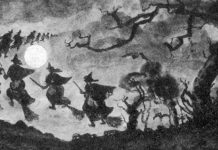The Salem Witch Trials are one of the darkest parts of American history. The trials are one of the most mythologized and miss-represented pieces of history in no small part because of the drama surrounding an entire community turning against one another. Around 150 people were accused of witchcraft including men, women and even children. Some were hanged and one was pressed to death. There are a number of myths, legends and flat out lies about the Salem Witch Trials. Here we will try to separate fact from fiction.

Salem Witch Trials: Facts & Myths
1. They were burned!
You’ll hear this one often and it is decidedly untrue in no small part because Salem town and Salem village were British colonies and in British lands witches were hanged, not burned. All the witches of Salem were hanged except for one, Giles Corey was the only witch convicted during the witch trials to not be hanged. He was pressed to death under stones after refusing to plead guilty or innocent. No one was burned. Learn more about the history of the Salem Witch trials here.
2. Only women were convicted and hanged!
Despite the pop-culture idea that only women can be witches and therefore only women were accused and convicted during the trials, there were men and children accused of witchcraft during the panic. And there were men hanged for it. Of the 19 individuals convicted of witchcraft and hanged for it, four of them were men. It’s important to understand that no one in the community of Salem was safe from being accused of witchcraft and in the end about 150 people were accused and tried. Even a minister was accused and hanged for witchcraft. No one was safe and that means that yes, men were convicted and did hang.
3. The panic was limited to Salem!
In fact the panic spread and infected 24 different communities in Massachusetts. Salem, what is now modern day Danvers, was simply the starting point of it all and the place where the trials themselves were held. In fact, though Salem was the seat of the panic, it was actually the town of Danvers about 15 miles away (quite a distance in the days of 1692) that suffered the most. One in ten of its residents were accused of witchcraft and indeed their most senior minister discovered by the end of the panic that he was related to no fewer than 22 “witches”.
4. Superstition drove them to panic!
Quite the contrary, it wasn’t superstition but piety. The people of this communities weren’t uneducated, in fact most of them could read. But in 1692 what did you have to read? Religious works. So some of the smarted, best educated individuals in the world worked entirely from their understanding of the law, history, and religion which absolutely condemned witchcraft as one of the worst crimes, and sins, someone could commit.
The Final Myth
One last myth frequently crops up and that is the idea that the girls of Salem who seemed to be possessed by evil spirits were, in fact, victims of ergot poisoning. However, there is far too much information to the contrary to make this a truly viable theory, not least of which is that these girls ate the same foods as their family members and yet no other family members experienced the same behaviors. The Salem witch trials will forever live in the memory of Americans as one of our darkest moments where we allowed false piety and panic to over-ride our common sense and destroyed both communities and lives with foolishness.















